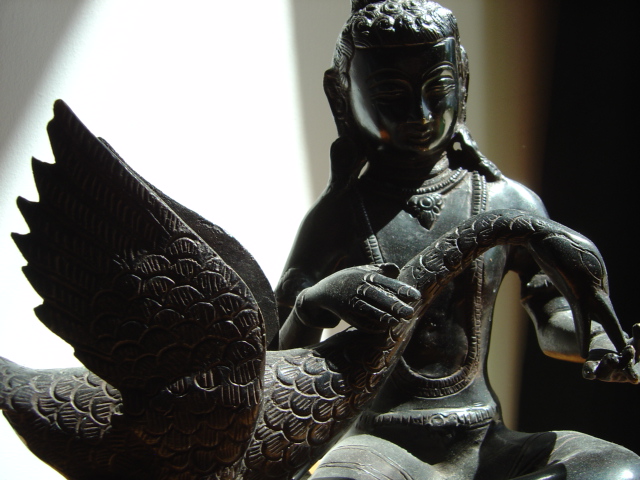De temps en temps, je demande aux personnes qui suivent mes cours, qu’est-ce qu’elles viennent faire là. Il ne s’agit pas d’une curiosité malsaine, mais, il me semble, que ce qui se déroule dans les cours est une double nourriture. Nous avons tous la même faim, et je tiens à m’assurer que nous tendons vers une même direction, qui n’est pas seulement l’apprentissage d’une technique ou la discipline d’une pratique, mais la recherche de l’essentiel.
L’enseignement est un paradoxe. D’abord, on libère du temps pour essayer de toucher une dimension qui n’en a pas, ensuite on utilise la parole pour atteindre un état de silence, on s’astreint à une immobilité qui ouvre sur une dynamique et finalement on utilise la détente pour accroître la concentration. La difficulté est de ne pas glisser du paradoxe à l’ambiguïté. Tout ceci est délicat et repose sur quelque chose qui est du domaine de la confiance. Cette confiance naît et se développe à travers la relation. Que j’écoute un enseignement, que j’en donne un ou que je lise le journal, je suis toujours dans une relation, une liaison. « Moi », est cette chose qui fait le lien. Je suis le lien. Au-delà du lien, se déploie ce que j’appelle, le Liant, un espace où se dissolvent et se dénouent tous les liens. Le « moi » s’avère vite un obstacle au Liant. A ce titre, il ne s’agit pas de le bannir, mais de le placer, de se placer, dans un processus inclusif. Le « moi » n’est pas un ennemi à abattre, car dans le processus d’inclusion, il n’y a pas d’ennemi. Tout est ami. La démarche pourrait se résumer à cela : rien n’est à exclure, tout est enseignement. Tous ceux qui viennent aux cours et moi-même, avons le même désir d’unité. La séparation qui s’installe lorsqu’on se trouve dans une logique d’exclusion, ne rompt pas seulement les liens extérieurs, elle morcelle aussi le dedans. Quand on vit dans la croyance de la séparation, on ne rencontre plus le réel et cela entretient une grande souffrance.
Bien sûr, tout ceci peut nous sembler de la théorie peu adaptée à notre environnement immédiat. Pour nous aider à intégrer cet autre rapport au monde dans notre quotidien, nous avons recourt aux pratiques. Celle du Nidra consiste à récupérer l’énergie libérée par un état de détente. Quand il y a moins de tension, il y a moins d’opposition. Les oppositions deviennent complémentaires, comme le jour et la nuit. Nous avons une vieille habitude qui consiste à dire : « je préfère ceci ou cela », une habitude qui découpe, pèse, mesure et entretient la fragmentation. Nous mettons donc l’énergie récupérée, au service de la concentration, en se concentrant sur des objets de plus en plus subtils qui visent à nous permettre de goûter la saveur incomparable du Liant.
Toute la pratique n’a qu’un seul objectif, se rapprocher et faire des incursions dans l’essentiel, dans l’indicible matière du Liant. Le désir de l’essentiel se cultive. De la même façon que je peux faire grandir un sentiment, je peux faire grandir mon désir de l’essentiel, qui n’ouvre pas sur un amour pour quelqu’un ou quelque chose mais sur un amour dépassant les limites d’un objet. Nous avons des quantités de désirs, mais c’est uniquement l’énergie du désir que pointe cet enseignement et non l’objet du désir. L’objet du désir est une impasse. Il ne faut pas attendre de l’objet du désir, un état libérateur, cela n’arrivera pas ; alors que l’énergie, elle, libère. Durant la pratique, nous procédons à un filtrage de plus en plus minutieux. Cela relève également du paradoxe, car l’énergie du désir se manifeste le plus souvent à travers l’objet du désir. En dissociant des images ou des objets de leur ambiance, nous apprenons à différencier l’énergie de son support. C’est un exercice à pratiquer aussi dans le quotidien. On demande, par exemple, lors d’une situation qui provoque un état de colère, de dissocier la raison ou la personne (l’objet), de l’énergie de la colère. Lorsqu’on réussit à faire distinctement la dissociation, l’objet se dissout aussitôt pour laisser place à la seule énergie qui ne porte plus alors de qualificatif. Elle n’est plus l’énergie de ceci ou de cela, mais simplement l’énergie libre de tout objet.
La relation implique toujours une tension, qu’il s’agisse d’une colère ou d’un désir. Il nous faut nourrir l’énergie du désir, mais sans la relation, sans la crispation, sans la tension. Vouloir s’approprier l’objet fait diminuer le désir, l’appropriation supprime peu à peu le désir. Si on réduit une relation amoureuse à de la possession, on en perd toute l’immensité, ce n’est plus une porte, mais un enfermement. Quand vous êtes touché, vivez la relation, que ce soit le sourire d’un enfant ou un accidenté de la route, vivez la relation à l’objet. L’important est seulement le lien, ce qui va permettre l’accès au Liant, et non l’objet. Nous sommes conditionnés à rechercher l’objectivité, l’objectivité équivaut à se réduire à l’objet, alors que ce qui prime, c’est la subjectivité, ce qui permet d’établir le lien. Il s’agit de se relier. Non pas pour se lier, non pas pour monter une armée, mais pour dire oui à sa vulnérabilité, à sa subjectivité. Bien sûr, le monde est dur et exige une relation de plus en plus intense à la souffrance. Mais il ne se réduit pas à cela. Ne vous attendez pas à ce que ce soit du gâteau, mais attendez-vous à ce que ce soit, aussi, du gâteau. Cela nous demande de désirer d’avantage la relation plutôt que les objets de la relation. Il en va de même dans notre relation au sacré. Lorsqu’on a fait suffisamment grandir l’énergie du désir, il arrive un moment où ne demeure plus que cette puissance nue. Au moment où l’objet (du désir) vole en éclat, le sujet disparaît aussi. Car objet et sujet n’existent que dans leur mutuelle tension. Si la tension se dissout, objet et sujet se dissolvent dans un même mouvement. Il n’y a plus personne et plus rien ! Il n’y a plus de relation possible. Seulement un état de communication impersonnel qui est la nature même du Liant.
Quand vous allez dans le sommeil, c’est de ça dont il est question, cette dissolution du sujet et de son objet. Nous sommes extrêmement vulnérables lorsque nous dormons. Et ultimement, il y aura cet événement définitif qu’on appelle la mort. Mais ce n’est pas la peine d’attendre sa venue pour en faire l’expérience. Le mourant et le naissant sont là en permanence, l’apparition et la dissolution forment le continuum de la vie. Cela est à envisager intellectuellement d’abord, mais il est nécessaire d’entrer ensuite dans la sensation. C’est à ce niveau là, que l’on va pouvoir commencer à devenir très attentif afin de ne plus faire obstacle à son déploiement. Pour entrer dans la sensation et la laisser se développer, nous allons devoir nous détendre, nous concentrer et désirer. Les petits exercices mis en place dans la pratique nous rapprochent du fondamental. Par exemple, un travail important va porter sur l’observation des états de passage, les moments où le mariage est proche, par exemple, le lever du jour ou l’approche de la nuit, le passage entre l’état de vieille et l’état de sommeil. Quand on observe comment le passage s’opère, on s’aperçoit qu’il n’y a pas de moment où l’on peut dire : « maintenant il fait jour, ou maintenant il fait nuit ». La notion de limite ne trouve plus sa place. Le passage est un état permanent, et ce que j’appelle « moi » en fait partie. Cet ensemble de constructions et de croyances qui détermine et objective en disant « ça c’est le jour, ça c’est la nuit » appartient lui aussi au passage. Le yoga permet de se rendre compte que les différences duelles telles qu’on les fabrique, sont, elles aussi, reliées entre elles : le jour n’est pas vraiment le jour car il glisse déjà vers la nuit. La nuit, n’est pas vraiment la nuit, car elle glisse déjà vers le jour. Cette chose qui croit être moi et crée de la séparation, nous pourrions tout aussi bien l’appeler la pensée. Il n’y a que la pensée qui crée des séparations. Lors de notre pratique, avec l’énergie récupérée pendant la détente, nous étudions le processus de la pensée, en prenant bien soin de ne pas chercher à l’exclure mais à lui rendre la place qui lui convient. Nous nous appuyons sur cette chose appelée « moi » pour diminuer progressivement l’identification à cet observateur. L’observation s’installe avec le moins d’effort possible, et peu à peu, nous délaissons l’observateur pour entrer dans une conscience différente. Lorsque le « moi » se relâche en acceptant de devenir passage, il épouse, entre et devient le flot de l’univers. L’observateur disparaît et cette disparition du centre (qui n’est en fait qu’une crispation), inaugure un détachement absolu. Dans ce détachement, naît la sensation de la disparition de la séparation. Il s’agit ici d’une expérience vécue qui a lieu dans le corps. Le détachement abolit instantanément toute relation. Car pour entretenir une relation, il faut être deux. Quand ce lien se désagrège, il ne reste que le Liant. La saveur de ce Liant s’apparente à la Joie et sa nature est celle du divin.
La saveur du Liant © André Riehl






2 Comments
Françoise Derouet
Bonjour Monsieur Riehl,
Merci beaucoup pour les cours de yoga nidra que vous dispensez en ligne, durant le mois de novembre 2020. C’est une grande joie pour moi de vivre cela avec vous.
Portez-vous bien.
Françoise
André Riehl
Bonsoir Françoise
Merci pour votre message.
Ce cycle d’enseignement en ligne arrive à sa fin, et il aura été une grande joie pour moi aussi.
Un nouveau programme de 20 séances en ligne devrait être prêt pour le début du mois de Janvier 2021…
Sans doute en recevrez vous le détail courant décembre
Recevez mon amitié et mon soutien dans votre quête
A